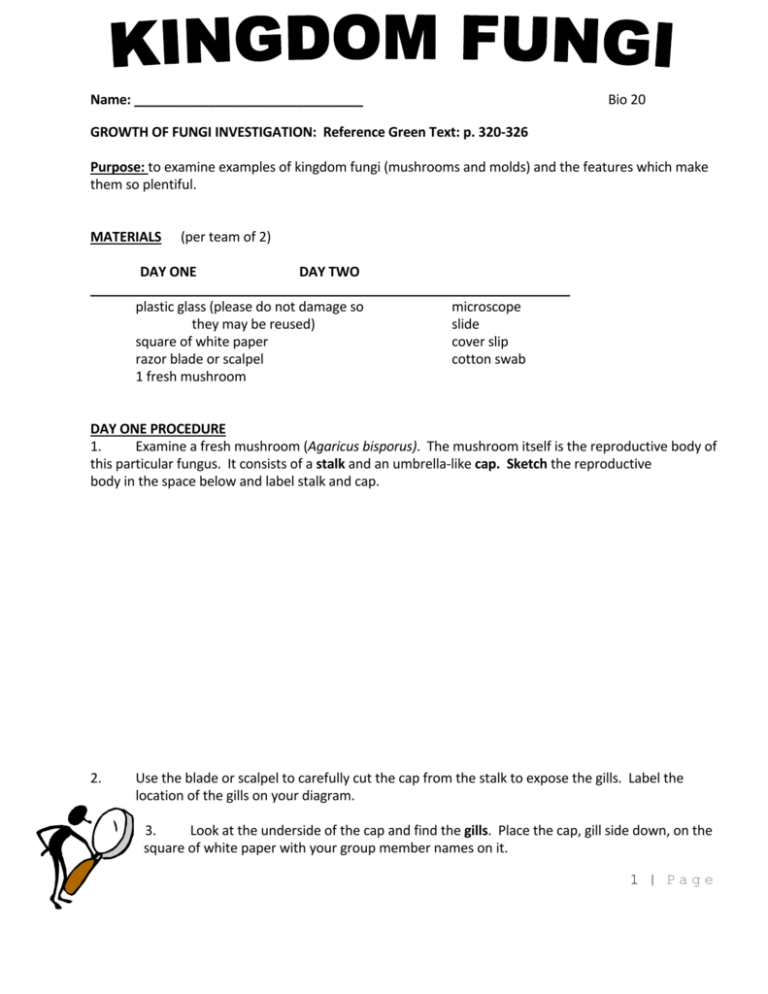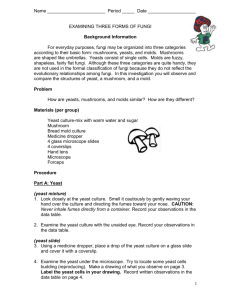Lab (Informal) Activity
advertisement

Name: _______________________________ Bio 20 GROWTH OF FUNGI INVESTIGATION: Reference Green Text: p. 320-326 Purpose: to examine examples of kingdom fungi (mushrooms and molds) and the features which make them so plentiful. MATERIALS (per team of 2) DAY ONE DAY TWO _________________________________________________________________ plastic glass (please do not damage so microscope they may be reused) slide square of white paper cover slip razor blade or scalpel cotton swab 1 fresh mushroom DAY ONE PROCEDURE 1. Examine a fresh mushroom (Agaricus bisporus). The mushroom itself is the reproductive body of this particular fungus. It consists of a stalk and an umbrella-like cap. Sketch the reproductive body in the space below and label stalk and cap. 2. Use the blade or scalpel to carefully cut the cap from the stalk to expose the gills. Label the location of the gills on your diagram. 3. Look at the underside of the cap and find the gills. Place the cap, gill side down, on the square of white paper with your group member names on it. 1 | Page 4. Place your mushroom cap and square of paper on the white tray and cover the cap with the glass to protect it from air currents. 5. Using Figure 12.19 on page 323, sketch and label a basidium with attached spores. Your Sketch Here: 6. Using your notes from class, determine which phylum this mushroom belongs in. PHYLUM _______________________ DAY TWO PROCEDURE 1. Remove the glass and lift the cap straight up from the paper. Replace the glass on the paper. What do you observe on the paper? Sketch what you see in the space below. 2. Obtain a cotton swab, tilt the glass and use the swab to transfer a small amount of this material to a slide. Add a drop or two of water and a cover slip. Discard the swab. 2 | Page 3. Examine the slide under low, medium and high power. Sketch one mushroom spore in the space provided. Approximately how many particles are present on the slide? (your best estimate) Make an estimate of the total number of particles coming from the mushroom. DISCUSSION QUESTIONS: 1) Why is the world not covered with mushrooms? 3 | Page 2) 3) How numerous would mushrooms be if they produced only a small fraction of the number of spores you calculated for one mushroom? Of what advantage is this large spore production to a fungus? Part 3: Examining Slides: A) B) Select a slide called Rhizopus nigricans (bread mold) from the slide box at the front of the room. Examine the slide at low, medium and high power. Select whichever power gives you the best image and draw this image. Be sure to calculate magnification of the slide. Be sure to label the Zygospore (dark brown, spiky looking sphere)and Hyphae Use the last page of this lab to draw your image. **Remember to estimate the number of cells across and which power you are using. Please note that you must calculate magnification by measuring and counting an individual hyphae or zygospore. You cannot just measure your entire drawing of different types of cells. Pick one cell type and use that to calculate magnification.** C) Take a look at the unlabelled slide of bread mold and check to see if you can locate the Zygospores and Hyphae. ** Too help you out with this section use the diagrams provided for you (i.e. the bread mold and mushroom lifecycle).*** in your duotang 4 | Page Demonstration Bench: Be sure to check out the displays that are set up in the classroom. Fill in the table. Name of Fungi Phylum Describe how it looks... 1) 2) 3) 4) 5) 6) 7) 8) 9) 10) 5 | Page Discussion Questions: 4) A) What phylum does Rhizopus nigricans mold belong to? B) What conditions must exist in order for bread mold to develop? 5) Suggest one way to prevent mold food items from becoming moldy. 6) A) Should you be concerned about the growth of mold in your home? Why? 6 | Page B) Suggest one way to prevent the growth of mold in your home. Conclusion: (Explain two things related to this lab that you have learned about Kingdom Fungi) You should hand in: 1) these handouts 2) Biological drawing of bread mold (make sure everything is labelled properly and that you have completed magnification calculations) **** Use the paper on the following page for your drawing. Biological Drawing Bread Mold 0—1—2—3—4—5 Pencil ____ Title ____ Drawing (Great, Good, Average, Cells not reflecting actual slide, getting disorganized, more effort for next time) Labels _____ - Zygospore - Hyphae Labels lined up to one side Size of Drawing ____; Magnification calculations (Good) (check calculations, check size of drawing in micrometres, check step 1, check step 2) ___; 7 | Page Bread Mold Drawing . . . 8 | Page




